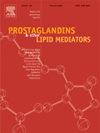氧化甾醇、年龄相关疾病和营养治疗:关注7-酮胆固醇和7- β-羟基胆固醇
IF 2.5
3区 生物学
Q3 BIOCHEMISTRY & MOLECULAR BIOLOGY
Prostaglandins & other lipid mediators
Pub Date : 2025-04-09
DOI:10.1016/j.prostaglandins.2025.106993
引用次数: 0
摘要
与年龄相关的疾病通常与氧化还原平衡的破坏有关,氧化还原平衡可导致脂质过氧化,形成氧化固醇,特别是在碳- 7,7 -酮胆固醇(也称为7-氧-胆固醇)和7- β-羟基胆固醇上氧化的脂质过氧化。像胆固醇一样,这些氧甾醇有27个碳,它们由甾烷核组成,在3号位置有羟基功能。7-酮胆固醇和7- β-羟基胆固醇主要由胆固醇自氧化形成,是氧化应激的生物标志物。这两种氧甾醇经常在患有与年龄有关的疾病,特别是心血管疾病、神经退行性疾病(主要是阿尔茨海默病)、眼部疾病(白内障、与年龄有关的黄斑变性)和肌肉减少症的患者的生物体液(血浆、脑脊液)、组织和/或器官(动脉壁、视网膜、大脑)中含量升高。根据所考虑的细胞类型,7-酮胆固醇和7- β-羟基胆固醇可诱导与线粒体和过氧化物酶体功能障碍、自噬和氧化应激相关的caspase依赖型或非依赖型细胞死亡。与氧化应激和自噬相关的caspase依赖性细胞死亡类型被定义为氧化凋亡。这两种氧甾醇也是炎症的诱导剂。这些与7-酮胆固醇和7β-羟基胆固醇毒性相关的生物学特征经常在年龄相关疾病患者中观察到,这表明这些氧甾醇参与了这些疾病的病理生理。在不同的细胞模型中,7-酮胆固醇和7- β-羟基胆固醇的细胞毒性作用被地中海饮食中的代表性营养物质ω3和ω9脂肪酸、多酚和生育酚所抵消。也有证据表明α-生育酚和酚类化合物对心血管疾病有益。7-酮胆固醇和7- β-羟基胆固醇在年龄相关疾病中经常升高,这些对7-酮胆固醇和7- β-羟基胆固醇的体外和体内观察增强了营养治疗的兴趣,以预防和/或治疗目前没有有效治疗方法的年龄相关疾病。本文章由计算机程序翻译,如有差异,请以英文原文为准。
Oxysterols, age-related-diseases and nutritherapy: Focus on 7-ketocholesterol and 7β-hydroxycholesterol
Age-related diseases are often associated with a disruption of RedOx balance that can lead to lipid peroxidation with the formation of oxysterols, especially those oxidized on carbon-7: 7-ketocholesterol (also known as 7-oxo-cholesterol) and 7β-hydroxycholesterol. Like cholesterol, these oxysterols have 27 carbons, they are composed of a sterane nucleus and have a hydroxyl function in position 3. The oxysterols 7-ketocholesterol and 7β-hydroxycholesterol are mainly formed by cholesterol autoxidation and are biomarkers of oxidative stress. These two oxysterols are frequently found at increased levels in the biological fluids (plasma, cerebrospinal fluid), tissues and/or organs (arterial wall, retina, brain) of patients with age-related diseases, especially cardiovascular diseases, neurodegenerative diseases (mainly Alzheimer’s disease), ocular diseases (cataract, age-related macular degeneration), and sarcopenia. Depending on the cell type considered, 7-ketocholesterol and 7β-hydroxycholesterol induce either caspase- dependent or -independent types of cell death associated with mitochondrial and peroxisomal dysfunctions, autophagy and oxidative stress. The caspase dependent type of cell death associated with oxidative stress and autophagy is defined as oxiapoptophagy. These two oxysterols are also inducers of inflammation. These biological features associated with the toxicity of 7-ketocholesterol, and 7β-hydroxycholesterol are often observed in patients with age-related diseases, suggesting an involvement of these oxysterols in the pathophysiology of these disorders. The cytotoxic effects of 7-ketocholesterol and 7β-hydroxycholesterol are counteracted on different cell models by representative nutrients of the Mediterranean diet: ω3 and ω9 fatty acids, polyphenols, and tocopherols. There are also evidences, mainly in cardiovascular diseases, of the benefits of α-tocopherol and phenolic compounds. These in vitro and in vivo observations on 7-ketocholesterol and 7β-hydroxycholesterol, which are frequently increased in age-related diseases, reinforce the interest of nutritherapeutic treatments to prevent and/or cure age-related diseases currently without effective therapies.
求助全文
通过发布文献求助,成功后即可免费获取论文全文。
去求助
来源期刊

Prostaglandins & other lipid mediators
生物-生化与分子生物学
CiteScore
5.80
自引率
3.40%
发文量
49
审稿时长
2 months
期刊介绍:
Prostaglandins & Other Lipid Mediators is the original and foremost journal dealing with prostaglandins and related lipid mediator substances. It includes basic and clinical studies related to the pharmacology, physiology, pathology and biochemistry of lipid mediators.
Prostaglandins & Other Lipid Mediators invites reports of original research, mini-reviews, reviews, and methods articles in the basic and clinical aspects of all areas of lipid mediator research: cell biology, developmental biology, genetics, molecular biology, chemistry, biochemistry, physiology, pharmacology, endocrinology, biology, the medical sciences, and epidemiology.
Prostaglandins & Other Lipid Mediators also accepts proposals for special issue topics. The Editors will make every effort to advise authors of the decision on the submitted manuscript within 3-4 weeks of receipt.
 求助内容:
求助内容: 应助结果提醒方式:
应助结果提醒方式:


